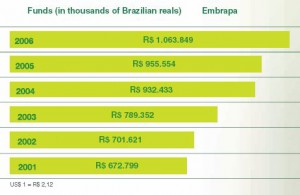Via Kate Gold at RBG Kew comes Charlie Riches‘ account of how he found the Striga-resistant cowpea B301 and how it came to IITA.
Here is the story of B301 — serendipity perhaps but not such a random find as the previous blog entries suggest!
If we think about origin and diversity in cowpea there should be no surprise to find Striga gesnerioides resistance in a landrace from Botswana — B301 is not the only one. I collected the seed in 1981, if my memory serves from the field of a farmer called Batleng near of the village of Kopong just a few miles from the Agricultural Research Station at Sebele. 1 At that time I was starting on my quest for resistance to the root parasite Alectra vogelii. 2 My hypothesis was that resistance may be available among the many landraces grown by farmers on fields infested by A. vogelii. I had observed that while landraces often had few parasites, fields of the introduced cultivar Blackeye would be thick with A. vogelii. So as I travelled around the villages where I was doing various agronomic trials with farmers I looked out for cowpea landrace plants that had no parasite stems growing near to them or maybe just one among stands of cowpea where there were otherwise many emerged A. vogelii.
During the 1981 harvest I collected 30 or 40 accessions that eventually were contributed to the Botswana Cowpea collection — they were all characterised and listed in the Botswana Cowpea Catalogue produced by colleagues at Sebele. I think my copy is in the attic! My collections were a pod or two from single plants so initially I had to multiply seed. Then I did a pot trial with 66 exotic and local lines, including 39 of my single plant selections, growing the plants in A. vogelii infested soil. This indicated possible resistance; i.e, no parasite attachments could be found on the roots washed from pots, in B301, B319 and B359. I reported this finding and subsequent confirmation trials at the 4th International Symposium on Parasitic Flowering Plants in Marburg. (Riches C. 1987. The Identification of Resistance to Alectra vogelii in Cowpea. pages 701-708 of the Proceedings).
Subsequently I screened 358 local accessions and found a further 12 with no emerged parasite stems. I continued working with a number of landraces that supported no or very few A. vogelii. In the end B359 proved to be the best source of resistance in pots and the field — B301 did sometimes allow the odd parasite stem to develop.
Anyway to continue the story! While I was working in Botswana I was in contact with Chris Parker, who had been working on Striga for many years at the Weed Research Organisation [near Oxford in the UK] (closed down in 1986). He visited Botswana to discuss my work and it made sense to us to check out if my A. vogelii-resistant materials were also useful for S. gesnerioides. By this time Chris was working at Long Ashton Research Station (now also closed!) and with Tess Polniaszek demonstrated that B301 showed resistance to Striga populations from Burkina Faso, Cameroon, Niger and Mali — the first line to have this multi-strain resistance (Parker, C. and Polniaszek, T.I. 1990. Parasitism of cowpea by Striga gesnerioides: variation in virulence and discovery of a new source of host resistance. Annals of Applied Biology, 116: 305-311). I provided all my Botswana accessions to B.B. Singh at IITA and the rest is history.
B301 is not the only line to provide dual parasite resistance in West Africa; there are now a number of others e.g. IT81D 849. Because there are a number of strains of A. vogelii, cowpea lines that are resistant in West Africa are not always so in East and Southern Africa. There is currently a group working in Malawi and Tanzania, funded by Collaborative Crop Research Program of the McKnight Foundation, that is developing resistant lines for southern Africa. B301 is being used as one parent in a back-cross breeding program. So after nearly 30 years the genes are on their way home!
What this story shows is the importance of collaboration and for researchers to share their findings.
Returning to the original comments in the blog I do not think it curious at all that resistance to S. gesnerioides can be found in Botswana where this species is very common but does not parasitise cowpea. As migrations and trade took cowpea across the continent from West Africa some landraces will probably have been taken from areas of West Africa infested by S. gesnerioides. 3
A more interesting question is why strains of Striga that are capable of attacking cowpea have not been disseminated from West to East and Southern Africa on cowpea seed! In these regions there are a number of distinct, host specific, morphotypic variants mainly on wild legumes and occasionally tobacco but never cowpea (see Ralston, Riches & Musselman, 1997. Morphology and hosts of three Striga species in Botswana. Adansonia 2, 195-215). 4
Thanks so much to Charles Riches for this account. Gotta love the interwebs.
